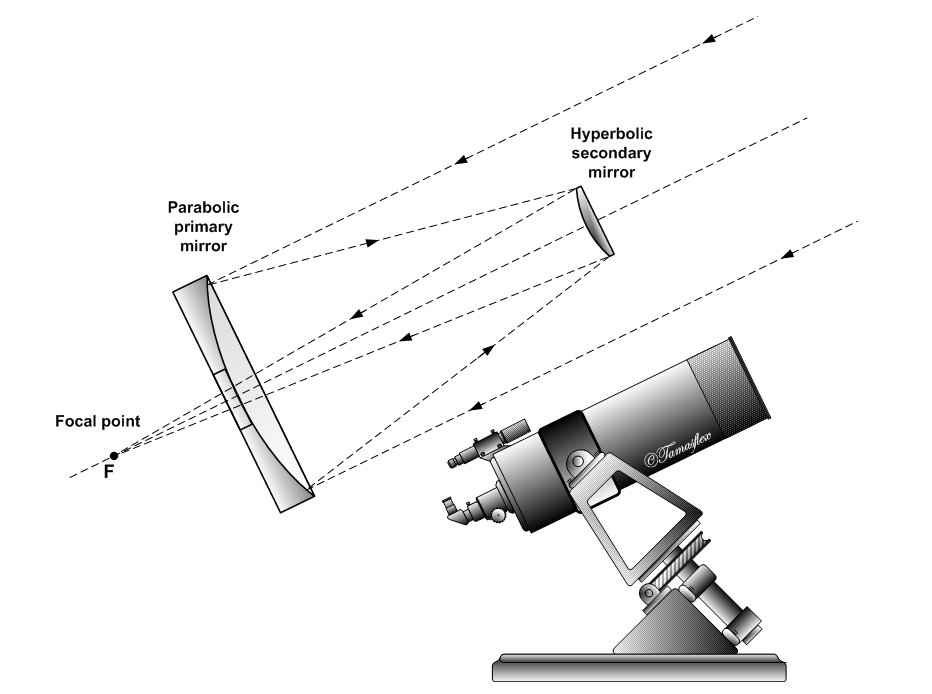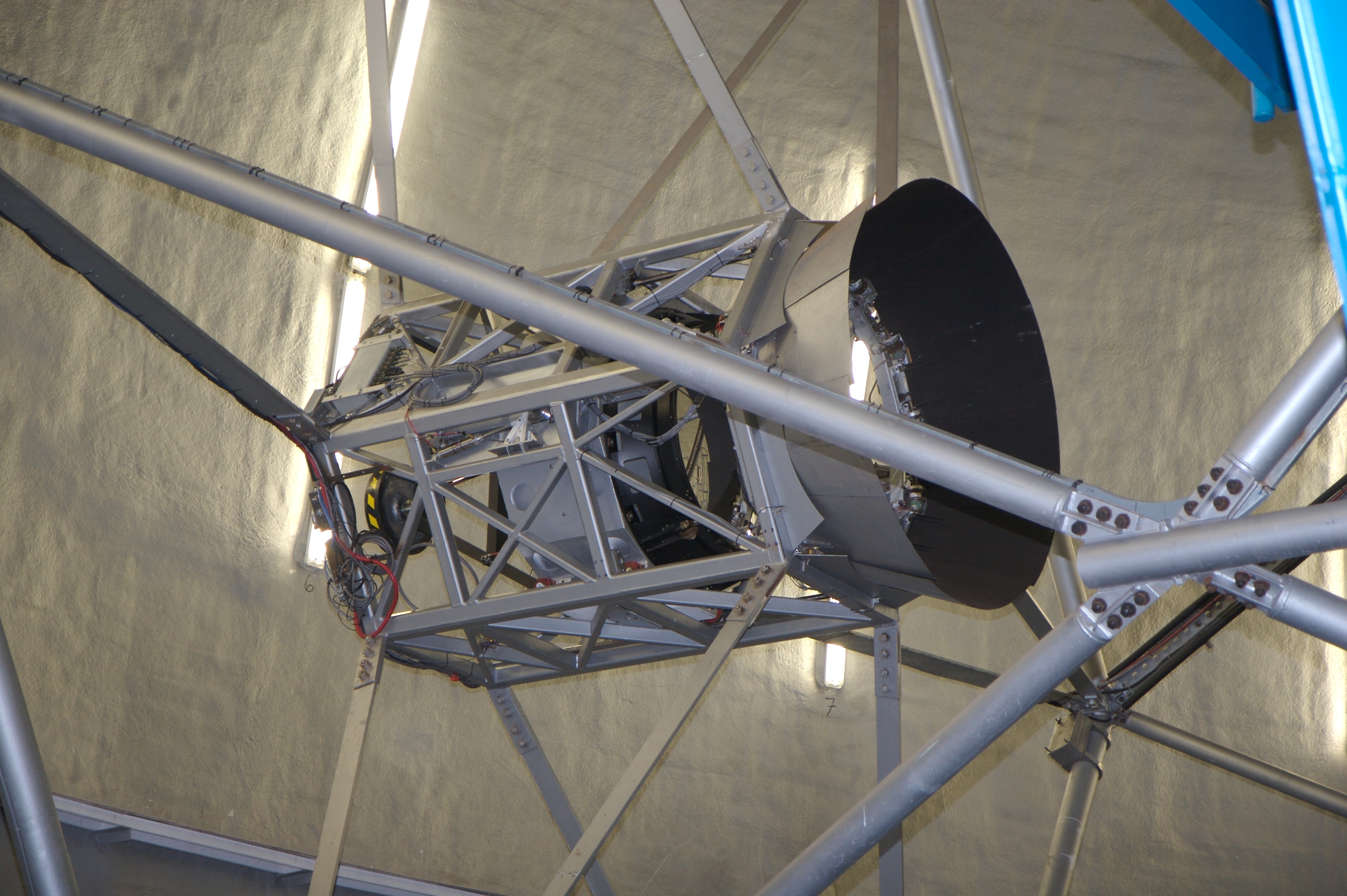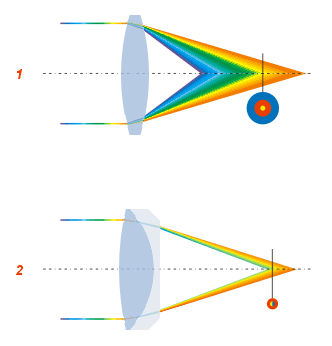|
Klevtsov–Cassegrain Telescope
The Klevtsov–Cassegrain telescope is a type of catadioptric Cassegrain telescope that uses a spherical primary mirror and a sub-aperture secondary corrector group composed of a small lens and a Mangin mirror. Design In the Klevtsov-Cassegrain, all of the optical surfaces are spherical or near-spherical. The secondary Mangin mirror () and the meniscus corrector (''C'') are held in place by a spider vane and the front of the telescope tube is otherwise open. These types of telescopes have the disadvantage of the spider, which holds the corrector, causing diffraction artifacts and, since multiple surfaces are involved, achieving good aberration correction can be very complex. This design was originally envisaged by G. I. Popov with a practical implementation by Yuri A. Klevtsov. Commercial manufacturers of the design include Novosibirsk TAL and Vixen. See also * Argunov–Cassegrain telescope * Cassegrain reflector * List of telescope types The following are lists of devic ... [...More Info...] [...Related Items...] OR: [Wikipedia] [Google] [Baidu] |
Catadioptric
A catadioptric optical system is one where refraction and reflection are combined in an optical system, usually via lenses ( dioptrics) and curved mirrors ( catoptrics). Catadioptric combinations are used in focusing systems such as searchlights, headlamps, early lighthouse focusing systems, optical telescopes, microscopes, and telephoto lenses. Other optical systems that use lenses and mirrors are also referred to as "catadioptric", such as surveillance catadioptric sensors. Early catadioptric systems Catadioptric combinations have been used for many early optical systems. In the 1820s, Augustin-Jean Fresnel developed several catadioptric lighthouse reflectors. Léon Foucault developed a catadioptric microscope in 1859 to counteract aberrations of using a lens to image objects at high power. In 1876 a French engineer, A. Mangin, invented what has come to be called the Mangin mirror, a concave glass reflector with the silver surface on the rear side of the glass. The two s ... [...More Info...] [...Related Items...] OR: [Wikipedia] [Google] [Baidu] |
Cassegrain Telescope
The Cassegrain reflector is a combination of a primary concave mirror and a secondary convex mirror, often used in optical telescopes and radio antennas, the main characteristic being that the optical path folds back onto itself, relative to the optical system's primary mirror entrance aperture. This design puts the focal point at a convenient location behind the primary mirror and the convex secondary adds a telephoto effect creating a much longer focal length in a mechanically short system. In a symmetrical Cassegrain both mirrors are aligned about the optical axis, and the primary mirror usually contains a hole in the center, thus permitting the light to reach an eyepiece, a camera, or an image sensor. Alternatively, as in many radio telescopes, the final focus may be in front of the primary. In an asymmetrical Cassegrain, the mirror(s) may be tilted to avoid obscuration of the primary or to avoid the need for a hole in the primary mirror (or both). The classic Cassegrain ... [...More Info...] [...Related Items...] OR: [Wikipedia] [Google] [Baidu] |
Spherical Reflector
A curved mirror is a mirror with a curved reflecting surface. The surface may be either ''convex'' (bulging outward) or ''concave'' (recessed inward). Most curved mirrors have surfaces that are shaped like part of a sphere, but other shapes are sometimes used in optical devices. The most common non-spherical type are parabolic reflectors, found in optical devices such as reflecting telescopes that need to image distant objects, since spherical mirror systems, like spherical lenses, suffer from spherical aberration. Distorting mirrors are used for entertainment. They have convex and concave regions that produce deliberately distorted images. They also provide highly magnified or highly diminished (smaller) images when the object is placed at certain distances. Convex mirrors A convex mirror or diverging mirror is a curved mirror in which the reflective surface bulges towards the light source. Convex mirrors reflect light outwards, therefore they are not used to focus light. Suc ... [...More Info...] [...Related Items...] OR: [Wikipedia] [Google] [Baidu] |
Primary Mirror
A primary mirror (or primary) is the principal light-gathering surface (the objective) of a reflecting telescope. Description The primary mirror of a reflecting telescope is a spherical or parabolic shaped disks of polished reflective metal ( speculum metal up to the mid 19th century), or in later telescopes, glass or other material coated with a reflective layer. One of the first known reflecting telescopes, Newton's reflector of 1668, used a 3.3 cm polished metal primary mirror. The next major change was to use silver on glass rather than metal, in the 19th century such was with the Crossley reflector. This was changed to vacuum deposited aluminum on glass, used on the 200-inch Hale telescope. Solid primary mirrors have to sustain their own weight and not deform under gravity, which limits the maximum size for a single piece primary mirror. Segmented mirror configurations are used to get around the size limitation on single primary mirrors. For example, the Gia ... [...More Info...] [...Related Items...] OR: [Wikipedia] [Google] [Baidu] |
Mangin Mirror
In optics, a Mangin mirror is a negative meniscus lens with the reflective surface on the rear side of the glass forming a curved mirror that reflects light without spherical aberration if certain conditions are met. This reflector was invented in 1876 by a French officer Alphonse Mangin as an improved catadioptric reflector for search lights and is also used in other optical devices. Description The Mangin mirror's construction consists of a concave ( negative meniscus) lens made of crown glass with spherical surfaces of different radii with the reflective coating on the shallower rear surface. The spherical aberration normally produced by the simple spherical mirror surface is canceled out by the opposite spherical aberration produced by the light traveling through the negative lens. Since light passes through the glass twice, the overall system acts like a triplet lens. The Mangin mirror was invented in 1876 by a French military engineer named Colonel Alphonse Mangin as a s ... [...More Info...] [...Related Items...] OR: [Wikipedia] [Google] [Baidu] |
Diagram Reflector KlevtsovCassegrain
A diagram is a symbolic representation of information using visualization techniques. Diagrams have been used since prehistoric times on walls of caves, but became more prevalent during the Enlightenment. Sometimes, the technique uses a three-dimensional visualization which is then projected onto a two-dimensional surface. The word ''graph'' is sometimes used as a synonym for diagram. Overview The term "diagram" in its commonly used sense can have a general or specific meaning: * ''visual information device'' : Like the term "illustration", "diagram" is used as a collective term standing for the whole class of technical genres, including graphs, technical drawings and tables. * ''specific kind of visual display'' : This is the genre that shows qualitative data with shapes that are connected by lines, arrows, or other visual links. In science the term is used in both ways. For example, Anderson (1997) stated more generally: "diagrams are pictorial, yet abstract, representati ... [...More Info...] [...Related Items...] OR: [Wikipedia] [Google] [Baidu] |
Optical Surfaces
In physics, refraction is the redirection of a wave as it passes from one medium to another. The redirection can be caused by the wave's change in speed or by a change in the medium. Refraction of light is the most commonly observed phenomenon, but other waves such as sound waves and water waves also experience refraction. How much a wave is refracted is determined by the change in wave speed and the initial direction of wave propagation relative to the direction of change in speed. For light, refraction follows Snell's law, which states that, for a given pair of media, the ratio of the sines of the angle of incidence ''θ1'' and angle of refraction ''θ2'' is equal to the ratio of phase velocities (''v''1 / ''v''2) in the two media, or equivalently, to the refractive indices (''n''2 / ''n''1) of the two media. :\frac =\frac=\frac Optical prisms and lenses use refraction to redirect light, as does the human eye. The refractive index of materials varies with the wavelengt ... [...More Info...] [...Related Items...] OR: [Wikipedia] [Google] [Baidu] |
Meniscus Corrector
A meniscus corrector is a negative meniscus lens that is used to correct spherical aberration in image-forming optical systems such as catadioptric telescopes. It works by having the equal but opposite spherical aberration of the objective it is designed to correct (usually a spherical mirror). Types Meniscus correctors are used as full aperture correctors, most commonly in a Maksutov telescope sub type called the Gregory or “spot” Maksutov–Cassegrain telescope. They are also used in the Bouwers meniscus telescope. There are Maksutov variations that use the same principle but place the meniscus lens as a sub-aperture corrector near the focus of the objective. There are other sub-aperture meniscus corrector catadioptric telescopes such as the Argunov–Cassegrain telescope and the Klevtsov–Cassegrain telescope. Invention The idea of using the spherical aberration of a meniscus lens to correct the opposite aberration in a spherical objective dates back as far as W. ... [...More Info...] [...Related Items...] OR: [Wikipedia] [Google] [Baidu] |
Spider Vane
A secondary mirror (or secondary) is the second deflecting or focusing mirror element in a reflecting telescope. Light gathered by the primary mirror is directed towards a focal point typically past the location of the secondary. Secondary mirrors in the form of an optically flat ''diagonal mirror'' are used to re-direct the light path in designs such as Newtonian reflectors. They are also used to re-direct and extend the light path and modify the final image in designs such as Cassegrain reflectors. The secondary is typically suspended by X-shaped struts (sometimes called a "spider") in the path of light between the source and the primary, but can be mounted on other types of mounts or optical elements such as optical windows, or schmidt and meniscus corrector plates. Employing secondary mirrors in optical systems causes some image distortion due to the obstruction of the secondary itself, and distortion from the spider mounts, commonly seen as cross-shaped diffraction spikes ... [...More Info...] [...Related Items...] OR: [Wikipedia] [Google] [Baidu] |
Diffraction Spike
Diffraction spikes are lines radiating from bright light sources, causing what is known as the starburst effect or sunstars in photographs and in vision. They are artifacts caused by light diffracting around the support vanes of the secondary mirror in reflecting telescopes, or edges of non-circular camera apertures, and around eyelashes and eyelids in the eye. Diffraction spikes due to support vanes In the vast majority of reflecting telescope designs, the secondary mirror has to be positioned at the central axis of the telescope and so has to be held by struts within the telescopes tube. No matter how fine these support rods are they diffract the incoming light from a subject star and this appears as diffraction spikes which are the Fourier transform of the support struts. The spikes represent a loss of light that could have been used to image the star. Although diffraction spikes can obscure parts of a photograph and are undesired in professional contexts, some amateur ... [...More Info...] [...Related Items...] OR: [Wikipedia] [Google] [Baidu] |
Optical Aberration
In optics, aberration is a property of optical systems, such as lenses, that causes light to be spread out over some region of space rather than focused to a point. Aberrations cause the image formed by a lens to be blurred or distorted, with the nature of the distortion depending on the type of aberration. Aberration can be defined as a departure of the performance of an optical system from the predictions of paraxial optics. In an imaging system, it occurs when light from one point of an object does not converge into (or does not diverge from) a single point after transmission through the system. Aberrations occur because the simple paraxial theory is not a completely accurate model of the effect of an optical system on light, rather than due to flaws in the optical elements. An image-forming optical system with aberration will produce an image which is not sharp. Makers of optical instruments need to correct optical systems to compensate for aberration. Aberration can be ana ... [...More Info...] [...Related Items...] OR: [Wikipedia] [Google] [Baidu] |







